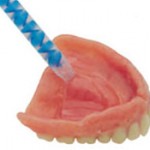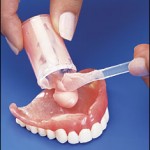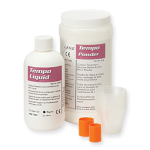Denture fitting is so crucial to comfortable use that a slight misalignment can create many far-reaching problems in your mouth. Due to the nature of gums, dentures need adjustments from time to time to properly fit. Gums and jawbone shrink with time as part of the natural aging process. Dentures that may have fit perfectly at first can become unsuitable for chewing as they loosen and slide around. Two types of adjustments are available: hard reline and soft reline. Both types of relines can either be performed in office or by using a do-it-yourself denture reline kit.
Hard Reline
To accommodate the changes in your palate and gum structures, a hard reline may be necessary. This is the kind of reline that should be done on all full dentures every two years. The hard reline is the ideal way to repair the fit of dentures without having to do a completely new fitting from scratch. The dentist removes some of the plastic from the inside of the denture, and then putty is placed on all areas of the denture that make contact with tissue, and an impression is made by placing the denture into your mouth when the putty hardens to a rubbery consistency. When the denture is removed, the denture now contains an accurate impression of the shape of the gums. The acrylic denture is then recreated by a lab, often on the same day, fitting your mouth perfectly. The impression material (putty) is replaced with pink, hard acrylic in exactly the same shape as the original impression material.
Some hard relines can be performed in office and still be considered long lasting, but hard relines can wear down your gums same as your hard plastic dentures can over time. With an office reline, the reline material is cured in the dentist’s office at the time of the reline.
Soft Reline
Occasionally, a patient finds that he cannot wear the denture because his gums are too tender, and he keeps getting sore spots. In cases where the patient is unable to wear ordinary dentures because of tender gums, the denture can be relined with a material that remains somewhat pliable for a year or two before it needs replacement. The consistency of this material can range from waxy to hard rubber, and is generally less likely to give the patient sore spots than ordinary pink acrylic.
A soft denture reline is still considered the best type of reline available and long lasting. The main difference with a soft reline is the material used to replace the hard acrylic. A softer, porous material is used, and provides more comfort for sensitive denture wearers. Soft relines, however, need more regular adjustments than hard relines.
Unfortunately, by the time that a patient resorts to a soft reline material to make the denture wearable, it usually means that factors other than simple sore spots are partly to blame for the difficulties that the patient is experiencing wearing the dentures. These could include an overbuilt denture or a resorbed ridge which is so unstable that the patient must keep constant force on the teeth to keep them in place. Both of these conditions can be corrected, sometimes with less expensive simple surgery or sometimes with much more expensive implant retained dentures.
Temporary Soft Reline (Therapeutic relines)
When neither a soft nor hard reline is comfortable for the patient, usually because of gum problems, a temporary soft reline may be used to keep the patient relatively pain free, using even softer materials. Frequently, by the time a patient with an old denture finally shows up at the dentist’s office looking for a new denture, the dentures have not been serviced for such a long time that the gums are in terrible condition. They may be red, swollen and quite misshapen. Relining the old denture, or building a new one using impressions taken while the gums are in such poor condition would lead to a denture that would simply perpetuate the problem with the new appliance.
This reline makes the denture fit much more tightly, and is usually soft and pliable. It will not last more than a few months, but the patient wears it for a few weeks until the gums return to a more normal state. Once the gums have healed completely, a true soft reline may be done, followed by a hard reline after a year or two.
Every Two Years
With gum resorption and natural bone changes, all dentures should be relined every two years. If significant changes or damages occur, a rebase may be more appropriate than a reline. Consult your dentist.
Warning
A reline works only when the impression of your bite was accurate from the start. A reline does not change the actual bite of the dentures. It merely ensures proper fit around the tissues and bone structure.



Hi my mom has recently gotten implants and her dentist is charging her an extra $850 for soft dentures is this price correct